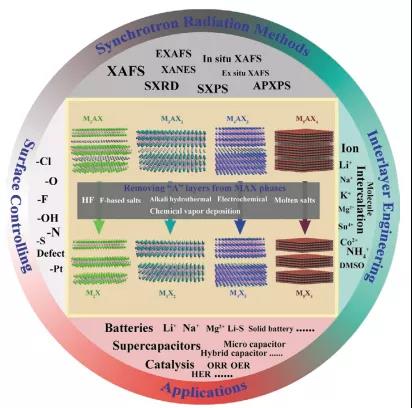AFM Overview: Surface Control and Interface Engineering of 2D MXenes
QQ Academic Group: 1092348845
Detailed
¡¾Research Background¡¿
In the past few years, since MXenes was first reported in 2011, it has been widely concerned by scientific researchers, and it has set off a wave of MXenes research. More than 150 different MAX phases and more than 30 MXenes have been synthesized And research. Thanks to the unique physical and chemical properties of MXenes, its outstanding biocompatibility has great potential in many different applications, such as the photodetector based on Mo 2 CT x , which utilizes MXene¡®s inherent plasma excitons Auxiliary hot carrier generation characteristics; nanofluid infiltration generator based on MXene / Kevlar nanofiber membrane; Ti 3 C 2 T x -based film for water purification; terahertz absorption of 3D MXene / GO foam and Ti 3 C 2 MXene Membrane thermoacoustic devices, etc.
At the same time, the fields of energy storage and conversion, such as supercapacitors, rechargeable batteries and catalysts, have been extensively studied, thanks to MXene¡®s large interlayer spacing and controllable surface functional groups. More importantly, the modification of surface functional groups and interlayer engineering can provide more electrochemically active sites and improve the electronic structure to improve the performance of MXenes, which has been confirmed in the application of energy-related fields.
Recently, Professor Song Li University of China Science and Technology Science Technology and Dr. Shuangming Chen in internationally renowned academic journal Advanced Functional Materials published title on to Tuning 2D MXenes by Surface Controlling and Interlayer Engineering: Methods, Properties, and Synchrotron Radiation Characterizations of review articles, a comprehensive system The surface control, interlayer engineering and synchronous X-ray absorption characterization of MXenes-based nanomaterials are summarized, and the prospect of MXenes materials and their application in advanced X-ray characterization methods is prospected.
¡¾Graphic introduction¡¿

Figure 1. Synthesis strategy, surface modification, interlayer engineering and synchrotron radiation of MXene- based nanomaterials .

Figure 2. The structure of functional groups on MXenes.

Figure 3. A summary of the preparation method for MXenes with functional groups on the surface or edges by selectively etching A atoms from the MAX phase.

Figure 4. The effect of the controlled surface functional groups and defects of MXenes on its electronic structure and performance.

Figure 5. MXene¡®s intercalation engineering is achieved through different intercalation methods.

Figure 6. XAFS characterization to explore the structural properties of the prepared MXene intercalation engineering before and after treatment.

Figure 7. The structure of MXenes is studied by Soft X-ray absorption spectroscopy.

Figure 8. Ex -situ and in-situ XAFS studies of MXenes .

Figure 9. Modified MXene material applied to batteries.

Figure 10. Modified MXene material used in catalysis.
¡¾Summary and Outlook¡¿
MXenes and MXenes-based materials have shown great potential in many research fields because of their rich surface functional groups and controllable interlayer spacing. At the same time, many characterization methods have been developed and applied to explore the structure and dynamic mechanism of MXenes materials. In addition, XAFS characterization based on synchrotron radiation source is also very helpful for exploring the structure and dynamic mechanism of MXenes. Because of its short-range sensitivity and element specificity, it has great advantages in exploring the microstructure of MXenes. Thanks to the multiple and single scattering of photoelectrons, XANES and EXAFS show sufficient sensitivity when exploring the oxidation state of MXenes and the local structure of absorbing atoms. Up to now, MXene and MXene-based materials have been proven to have great advantages and potential in supercapacitors, batteries, catalysis and many other fields based on their surface modification and interlayer engineering technology. Although the surface functional groups and interlayer engineering of MXenes have a very important influence on its structure and application, the research on the influence of a single functional group is usually limited to theoretical calculations. Therefore, there is still a need for novel synthesis methods and subsequent processing methods to prepare MXenes with specific surface functional groups. Researchers need to work harder to study selective intercalation through specific intercalating agents to improve performance. On the other hand, the design of MXene-based composite materials with outstanding performance is also crucial for their breakthrough in various fields. It is worth noting that, benefiting from the development of SR light sources and the need for in-depth research on the structure and mechanism of MXenes in the corresponding fields, many other SR-based characterization methods besides XAS are urgently needed to be developed to explore and develop MXenes materials, such as SXRD, SXPS, XR-based FTIR and APXPS technologies, etc.
Literature link:
https://doi.org/10.1002/adfm.202000869
Source:
- Previous£º JMCA: Theoretical calc
- Next£º MXene breakthrough: Na


 mxene academic
mxene academic
